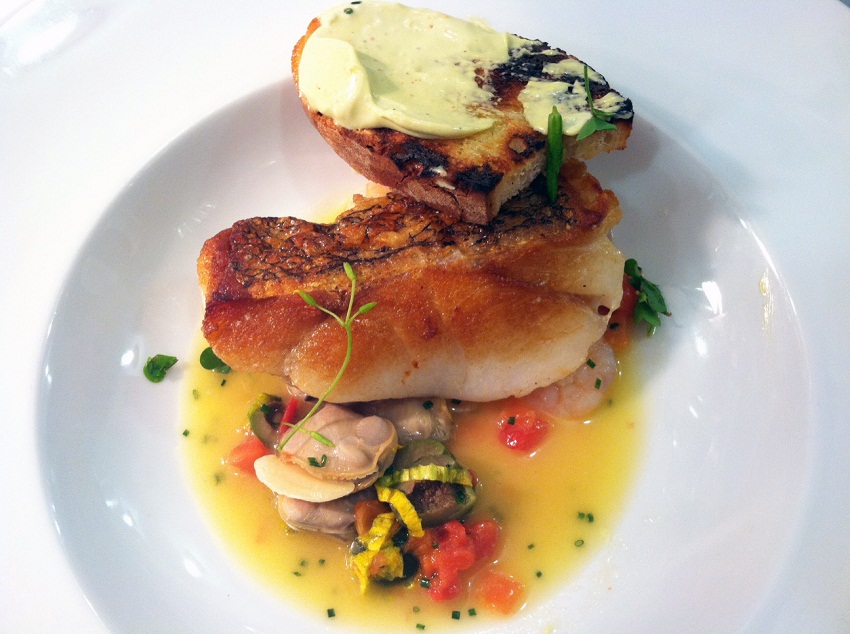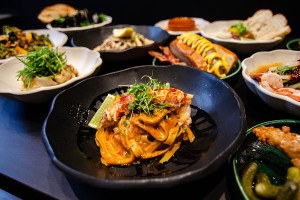Chefology: Plankton, a Microscopic Spice of the Sea
The diversity of life in the world’s oceans provides chefs with an incredible palette of flavors. From the salty melon essence of Kumamoto oysters to the explosive beach-in-your-mouth experience of uni, ocean animals express as wide a range of flavor profiles as their terrestrial counterparts. But animals aren’t the only way to incorporate tastes of the sea into a meal. Microscopic plants called phytoplankton are giving chefs in Boston and all over the world new ways to satisfy our maritime cravings.
The world’s oceans are packed full of phytoplankton. These tiny green cells float around in the sunlit layers of ocean. They absorb light and use it to make energy through photosynthesis just as green plants on land use sunlight for power. Phytoplankton are small, but their impact on our planet is huge: they produce a large amount of the oxygen that makes up our atmosphere and serve as a food source for many parts of the world’s oceanic food webs. Technically speaking, this green ocean confetti isn’t just plant life: it’s a diverse group of organisms ranging from bacteria to protists, but it does include some true single-celled plants called algae.
Phytoplankton caught on in the culinary world thanks in part to the Spanish chef Ángel León. When looking for new ways to incorporate the flavors of the ocean into dishes at his Michelin-starred restaurant Aponiente, León figured out how to harness flavors from phytoplankton in his kitchen. As León learned the hard way, not all phytoplankton are safe for human consumption. Some species of phytoplankton, such as red tide, produce nasty toxins so they cannot be directly harvested from ocean waters. León has worked with algal biologists to develop a method for growing different species of phytoplankton in a lab, with each species having it’s own unique flavor profile.
Freeze-dried phytoplankton. Inset shows a microscopic view of individual cells of the phytoplankton.
Why does phytoplankton taste like the ocean? What are the chemicals that make those classic marine flavors? Because the use of phytoplankton in fine dining is relatively new, there hasn’t been any research done on the flavor chemistry of this sea spice so we can’t know for sure. Most of the research on phytoplankton flavors comes from freshwater fish farms where blooms of undesirable algae cause off-flavors in the taste of the fish. Scientists have identified the chemicals responsible for these flavors as geosmin and 2-methylisoborneol, but these chemicals result in earthy and musty aromas (think patchouli) not the briney and metallic freshness we associate with ocean flavors. With that unsatisfying answer, we asked UC Davis flavor chemist Arielle Johnson to make some educated guesses about the flavor chemistry of phytoplankton. Based on research on oysters and Japanese seaweed, she suspects that compounds called halogenated organic compounds that contain iodine, chlorine, bromine could create that distinct briny flavors that chefs love.
The phytoplankton used at No. 9 Park comes as a freeze-dried green powder from Browne Trading Company in Portland, Maine. Veta La Palma, an aquaculture farm in Spain, grows the phytoplankton in a lab ensuring that it’s safe and free from any toxic phytoplankton. They offer two varieties: a “Mediterranean Taste,” a marine algal species named Tetraselmi chuii and “South Bay Taste,” the algal species Nannochloropsis gaditana which can live in freshwater. The flavor difference is slight, but the former is described as ocean plant flavor, while the South Bay tastes more fishy. On its own, the smell of the phytoplankton is intense. Just a tiny pinch of the green powder provides a big burst of that quintessential ocean aroma: brine and seaweed, the smell of fresh shrimp shells, the cleanest version of a lobster pound.
Phytoplankton is currently on the menu at No. 9 with a summer version of bouillabaisse. Atlantic hake on a ragout of heirloom tomatoes, olives, shellfish, squash blossoms and basil is topped with the traditional rouille, grilled bread with a saffron aioli. In this case, we mix the plankton right into the aioli, infusing it with just the right amount of brine as you soak up the broth with the bread. It’s easy to do at home, too: just mix some powdered plankton in with your favorite mayonnaise.
A hake dish at No. 9 Park that incorporates a phytoplankton aioli.
The powdered plankton also makes an incredible broth. On our weekly-changing tasting menu, we had diver scallop crudo with a broth seasoned with plankton. We took the scallop roe, shallot, white pepper, prosecco, water, and a pinch of plankton, and let it simmer for hours before straining it slowly and leaving us with a clear golden-colored broth that tasted like a mermaid’s cocktail.
As with most culinary innovations, the Europeans are at the forefront and are now supplying American chefs with this incredibly pricey green spice of the sea. As far as we know, no one is selling American phytoplankton strains. Hopefully some algae enthusiast will forage (with a microscope in hand) for American phytoplankton that could end up on fine dining menus or in our spice cabinets. Who knows? The next marine flavor sensation could be floating in Boston Harbor right now.




